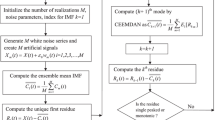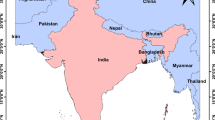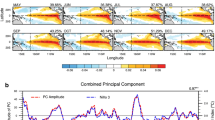Abstract
Using the ensemble empirical mode decomposition method, this study systematically investigates the multiple timescales of the southern annular mode (SAM) and identifies their relative contributions to the persistence of the SAM. Analyses show that the persistence of SAM mainly depends on the contribution of longer-timescale variabilities, especially the cross-seasonal variability of SAM. When subtracting the cross-seasonal variability from the SAM, the long-term positive covariance between the eddy forcing and zonal flow disappears. Composite analysis shows that the meridional shift of zonal wind, eddy momentum forcing and baroclinicity anomalies can be maintained for more than 40 days only under the circumstance of strong cross-seasonal variability, indicating the dominant role played by the cross-seasonal variability for the low-frequency persistence of the SAM. Analysis further shows that the cross-seasonal variability of the SAM, in addition to the internal dynamics, is associated with the extratropical air–sea interaction. About half of the strong cross-seasonal SAM events are accompanied by evident extratropical dipolar SST anomalies, which mostly occur in austral summer. The cross-seasonal dependence of the low-frequency change in SAM suggests that the contribution of longer-timescale variabilities, especially the cross-seasonal variability, cannot be neglected in subseasonal prediction of the SAM.










Similar content being viewed by others
Data availability
The ERA-Interim reanalysis data used in this study were downloaded from ECMWF (https://www.ecmwf.int/en/forecasts/datasets/reanalysis-datasets/era-interim). The SST data were downloaded from NOAA (https://psl.noaa.gov/data/gridded/data.noaa.oisst.v2.html). The sea ice concentration data were downloaded from Hadley Center (HadlSST1; https://www.metoffice.gov.uk/hadobs/hadisst/data/download.html) and the ocean surface current data were downloaded from GODAS (http://cfs.ncep.noaa.gov/cfs/godas).
References
Ayres HC, Screen JA (2019) Multi-model analysis of the atmospheric response to Antarctic sea ice loss at quadrupled CO2. Geophys Res Lett 46:9861–9869. https://doi.org/10.1029/2019GL083653
Baldwin MP, Stephenson DB, Thompson DWJ et al (2003) Stratospheric memory and skill of extended-range weather forecasts. Science 301(5633):636–640. https://doi.org/10.1126/science.1087143
Barnes EA, Hartmann DL (2011) Rossby wave scales, propagation, and the variability of eddy-driven jets. J Atmos Sci 68(12):2893–2908. https://doi.org/10.1175/JAS-D-11-039.1
Behringer DW, Ji M, Leetmaa A (1998) An improved coupled model for ENSO prediction and implications for ocean initialization. Part I: the ocean data assimilation system. Mon Weather Rev 126(4):1013–1021. https://doi.org/10.1175/1520-0493(1998)126<1013:AICMFE>2.0.CO;2
Black RX, Mcdaniel BA (2007) Interannual variability in the southern hemisphere circulation organized by stratospheric final warming events. J Atmos Sci 64(8):2968–2974. https://doi.org/10.1175/JAS3979.1
Bromwich DH, Rogers AN, Kallberg P et al (2000) ECMWF analyses and reanalyses depiction of ENSO signal in Antarctic precipitation. J Clim 13(8):1406–1420. https://doi.org/10.1175/1520-0442(2000)013%3c1406:EAARDO%3e2.0.CO;2
Bromwich DH, Monaghan AJ, Guo Z (2004) Modeling the ENSO modulation of Antarctic climate in the late 1990s with the polar mm5. J Clim 17(1):109–132. https://doi.org/10.1175/1520-0442(2004)0172.0.CO;2
Byrne NJ, Shepherd TG, Woollings T, Plumb RA (2017) Nonstationarity in southern hemisphere climate variability associated with the seasonal breakdown of the stratospheric polar vortex. J Clim 30(18):7125–7139. https://doi.org/10.1175/JCLI-D-17-0097.1
Codron F (2006) Relation between annular modes and the mean state: southern hemisphere summer. J Atmos Sci 64(2):3328–3339. https://doi.org/10.1175/JAS4012.1
Dai X, Zhang Y, Yang XQ (2021) The budget of local available potential energy of low-frequency eddies in Northern Hemispheric winter. J Clim 34(4):1241–1258. https://doi.org/10.1175/JCLI-D-19-1007.1
Daubechies I (1998) Ten lectures on wavelets. Comput Phys 6(3):1671. https://doi.org/10.1063/1.4823127
Delsole T, Trenary L, Tippett MK, Pegion K (2017) Predictability of week-3-4 average temperature and precipitation over the contiguous united states. J Clim 30(10):3499–3512. https://doi.org/10.1175/JCLI-D-16-0567.1
Ding H, Greatbatch RJ, Gollan G (2014) Tropical impact on the interannual variability and long-term trend of the Southern Annular Mode during austral summer from 1960/1961 to 2001/2002. Clim Dyn 44:2215–2228. https://doi.org/10.1007/s00382-014-2299-x
Dou J, Wu Z, Li J (2020) The strengthened relationship between the Yangtze River Valley summer rainfall and the Southern Hemisphere annular mode in recent decades. Clim Dyn 54:1607–1624. https://doi.org/10.1007/s00382-019-05078-4
Duchon CE (1979) Lanczos filtering in one and two dimensions. J Appl Meteor 18(8):1016–1022. https://doi.org/10.1175/1520-0450(1979)018%3c1016:LFIOAT%3e2.0.CO;2
Fogt RL, Bromwich DH (2004) Decadal variability of the ENSO teleconnection to the high-latitude south pacific governed by coupling with the southern annular mode. J Clim 19(6):979–997. https://doi.org/10.1175/JCLI3671.1
Gillett NP, Kell TD, Jones PD (2006) Regional climate impacts of the southern annular mode. Geophys Res Lett 33(23):160–176. https://doi.org/10.1029/2006GL027721
Gong DY, Wang WS (1999) Definition of Antarctic Oscillation index. Geophys Res Lett 26:459–462. https://doi.org/10.1029/1999GL900003
Gupta AS, England MH (2006) Coupled ocean–atmosphere–ice response to variations in the southern annular mode. J Clim 19(18):4457–4486. https://doi.org/10.1175/JCLI3843.1
Hartmann DL, Lo F (1997) Wave-driven zonal flow vacillation in the southern hemisphere. J Atmos Sci 55(8):1303–1315. https://doi.org/10.1175/1520-0469(1998)0552.0.CO;2
Huang NE, Shen Z, Long SR, Wu MC et al (1998) The empirical mode decomposition method and the Hilbert spectrum for non-stationary time series analysis. Proc R Soc Lond 454A:903–995. https://doi.org/10.1098/rspa.1998.0193
Huang NE, Shen Z, Long RS (1999) A new view of nonlinear water waves: t he Hilbert spectrum. Annu Rev Fluid Mech 31:417–457. https://doi.org/10.1146/annurev.fluid.31.1.417
Huang B, Hu Z, Iii JLK, Wu Z, Kumar A (2012a) Connection of stratospheric QBO with global atmospheric general circulation and tropical SST. part I: methodology and composite life cycle. Clim Dyn 38(1–2):1–23. https://doi.org/10.1007/s00382-011-1250-7
Huang B, Hu Z, Schneider EK, Wu Z, Xue Y, Klinger B (2012b) Influences of subtropical air–sea interaction on the multidecadal AMOC variability in the NCEP climate forecast system. Clim Dyn 39(3–4):531–555. https://doi.org/10.1007/s00382-011-1258-z
Jiang T, Deng Y, Li W (2013) Local kinetic energy budget of high-frequency and intermediate-frequency eddies: winter climatology and interannual variability. Clim Dyn 41(3–4):961–976. https://doi.org/10.1007/s00382-013-1684-1
Kidston JA, Taschetto AS, Thompson DWJ, England MH (2011) The influence of southern hemisphere sea-ice extent on the latitude of the mid-latitude jet stream. Geophys Res Lett 38:L15804. https://doi.org/10.1029/2011GL048056
L’Heureux ML, Thompson DWJ (2005) Observed relationships between the El Nino–southern oscillation and the extratropical zonal-mean circulation. J Clim 19(2):276–287. https://doi.org/10.1175/JCLI3617.1
Lim EP, Hendon HH, Rashid H (2013) Seasonal predictability of the southern annular mode due to its association with ENSO. J Clim 26(20):8037–8054. https://doi.org/10.1175/JCLI-D-13-00006.1
Lim EP, Hendon HH, Thompson DWJ (2018) Seasonal evolution of stratosphere-troposphere coupling in the southern hemisphere and implications for the predictability of surface climate. J Geophys Res Atmos 123(21):12002–12016. https://doi.org/10.1029/2018jd029321
Liu T, Li J, Li Y, Zhao S, Zheng F, Zheng J, Yao Z (2018) Influence of the May Southern annular mode on the South China Sea summer monsoon. Clim Dyn 51:4095–4107. https://doi.org/10.1007/s00382-017-3753-3
Lorenz EN (1956) Empirical orthogonal functions and statistical weather prediction. Scientific Report No. 1, Statistical Forecasting Project. MIT, Cambridge, p 48
Lorenz DJ, Hartmann DL (2001) Eddy–zonal flow feedback in the southern hemisphere. J Atmos Sci 58(21):3312–3327. https://doi.org/10.1175/1520-0469(2001)0582.0.CO;2
Love BS, Matthews AJ, Janacek GJ (2008) Real-time extraction of the Madden–Julian oscillation using empirical mode decomposition and statistical forecasting with a VARMA model. J Clim 21(20):5318–5335. https://doi.org/10.1175/2008JCLI1977.1
Ma D, Hassanzadeh P, Kuang Z (2016) Quantifying the eddy-jet feedback strength of the annular mode in an idealized GCM and reanalysis data. J Atmos Sci 74(2):393–407. https://doi.org/10.1175/JAS-D-16-0157.1
Morgenstern O, Zeng G, Dean SM, Joshi M, Abraham NL, Osprey A (2014) Direct and ozone-mediated forcing of the southern annular mode by greenhouse gases. Geophys Res Lett 41(24):9050–9057. https://doi.org/10.1002/2014GL062140
Munoz AG, Goddard L, Mason, et al (2016a) Cross-time scale interactions and rainfall extreme events in southeastern south America for the austral summer. Part I: potential predictors. J Clim 28(19):7894–7913. https://doi.org/10.1175/JCLI-D-14-00693.1
Munoz AG, Goddard L, Robertson, et al (2016b) Cross-time scale interactions and rainfall extreme events in southeastern south America for the austral summer. Part II: predictive skill. J Clim 29(16):5915–5934. https://doi.org/10.1175/JCLI-D-15-0699.1
Nie Y, Zhang Y, Yang XQ, Chen G (2013) Baroclinic anomalies associated with the southern hemisphere annular mode: roles of synoptic and low-frequency eddies. Geophys Res Lett 40:2361–2366. https://doi.org/10.1002/grl.50396
Nie Y, Zhang Y, Chen G, Yang XQ, Burrows DA (2014) Quantifying barotropic and baroclinic eddy feedbacks in the persistence of the southern annular mode (SAM). Geophys Res Lett 41(23):8636–8644. https://doi.org/10.1002/2014GL062210
Nie Y, Zhang Y, Chen G, Yang XQ (2016) Delineating the barotropic and baroclinic mechanisms in the midlatitude Eddy-driven jet response to lower-tropospheric thermal forcing. J Atmos Sci 73(1):429–448. https://doi.org/10.1175/JAS-D-15-0090.1
North GR, Bell TL, Cahalan RF, Moeng FJ (1982) The latitude dependence of the variance of zonally averaged quantities. Mon Weather Rev 110(5):319–326. https://doi.org/10.1175/1520-0493(1982)110%3c0319:TLDOTV%3e2.0.CO;2
Pan H, Guo Z, Wang Y, Lv X (2018) Application of the EMD method to river tides. J Atmos Ocean Tech 35(4):809–819. https://doi.org/10.1175/JTECH-D-17-0185.1
Qian C, Wu Z, Fu C, Zhou T (2010) On multi-timescale variability of temperature in china in modulated annual cycle reference frame. Adv Atmos Sci 27(5):1169–1182. https://doi.org/10.1007/s00376-009-9121-4
Rayner NA, Parker DE, Horton EB et al (2003) Global analyses of sea surface temperature, sea ice, and night marine air temperature since the late nineteenth century. J Geophys Res Atmos. https://doi.org/10.1029/2002JD002670
Reynolds RW, Rayner NA, Smith TM et al (2001) An improved in situ and satellite SST analysis for climate. J Clim 15(13):1609–1625. https://doi.org/10.1175/1520-0442(2002)015%3c1609:AIISAS%3e2.0.CO;2
Robert L, Rivière G, Codron F (2017) Positive and negative eddy feedbacks acting on midlatitude jet variability in a three-level quasigeostrophic model. J Atmos Sci 74(5):1635–1649. https://doi.org/10.1175/JAS-D-16-0217.1
Simpson IR, Shepherd TG, Hitchcock P, Scinocca JF (2013) Southern annular mode dynamics in observations and models. Part II: eddy feedbacks. J Clim 26(14):5220–5241. https://doi.org/10.1175/JCLI-D-12-00495.1
Stammerjohn SE, Martinson DG, Smith RC, Yuan X, Rind D (2008) Trends in Antarctic annual sea ice retreat and advance and their relation to El Niño–southern oscillation and southern annular mode variability. J Geophys Res Oceans. https://doi.org/10.1029/2007JC004269
Thompson DWJ, Solomon S (2002) Interpretation of recent southern hemisphere climate change. Science 296(5569):895–899. https://doi.org/10.1126/science.1069270
Thompson DWJ, Wallace JM (2000) Annular modes in the extratropical circulation. Part I: month-to-month variability. J Clim 13(5):1000–1016. https://doi.org/10.1175/1520-0442(2000)0132.0.CO;2
Thompson DWJ, Woodworth JD (2014) Barotropic and baroclinic annular variability in the southern hemisphere. J Atmos Sci 71(4):1480–1493. https://doi.org/10.1175/JAS-D-13-0185.1
Vigaud N, Robertson AW, Tippett MK (2017) Multi-model ensembling of subseasonal precipitation forecasts over north America. Mon Weather Rev 145:3913–3928. https://doi.org/10.1175/MWR-D-17-0092.1
Wallace RK, Benson H (1972) The physiology of meditation. Sci Am 226(2):84–90. https://doi.org/10.1038/scientificamerican0272-84
Wang L, Robertson AW (2019) Week 3–4 predictability over the united states assessed from two operational ensemble prediction systems. Clim Dyn 52:5861–5875. https://doi.org/10.1007/s00382-018-4484-9
Wang L, Ting M, Kushner PJ (2017) A robust empirical seasonal prediction of winter NAO and surface climate. Sci Rep 7(1):279. https://doi.org/10.1038/s41598-017-00353-y
Wang S, Liu J, Cheng X et al (2021) How do weakening of the stratospheric polar vortex in the Southern Hemisphere affect regional Antarctic sea ice extent? Geophys Res Lett 48:e2021GL092582. https://doi.org/10.1029/2021GL092582
Wu Z, Huang NE (2009) Ensemble empirical mode decomposition: a noise-assisted data analysis method. Adv Adapt Data Anal 1:1–41. https://doi.org/10.1142/S1793536909000047
Wu Z, Schneider EK, Kirtman BP, Sarachik ES, Huang NE, Tucker CJ (2008) The modulated annual cycle: an alternative reference frame for climate anomalies. Clim Dyn 31:823–841. https://doi.org/10.1007/s00382-008-0437-z
Wu Z, Huang NE, Wallace JM, Smoliak BV, Chen X (2011) On the time-varying trend in global-mean surface temperature. Clim Dyn 37(3–4):759–773. https://doi.org/10.1007/s00382-011-1128-8
Xiao B, Zhang Y, Yang XQ, Nie Y (2016) On the role of extratropical air–sea interaction in the persistence of the southern annular mode. Geophys Res Lett 43:8806–8814. https://doi.org/10.1002/2016GL070255
Yu J, Paek H, Saltzman ES, Lee T (2008) The early 1990s change in ENSO–PSA–SAM relationships and its impact on southern hemisphere climate. J Clim 28(23):9393–9408. https://doi.org/10.1175/JCLI-D-15-0335.1
Yuan X, Yonekura E (2011) Decadal variability in the southern hemisphere. J Geophys Res Atmos. https://doi.org/10.1029/2011JD015673
Zbilut JP, Marwan N (2008) The Wiener-Khinchin theorem and recurrence quantification. Phys Lett A 372(44):6622–6626. https://doi.org/10.1016/j.physleta.2008.09.027
Zhang Y, Yang XQ, Nie Y, Chen G (2012) Annular mode-like variation in a multilayer quasigeostrophic model. J Atmos Sci 69(10):2940–2958. https://doi.org/10.1175/JAS-D-11-0214.1
Zheng F, Li J, Wang L, Xie F, Li X (2015a) Cross-seasonal influence of the December–February southern hemisphere annular mode on March–May meridional circulation and precipitation. J Clim 28(17):6859–6881. https://doi.org/10.1175/JCLI-D-14-00515.1
Zheng F, Li J, Feng J, Li Y (2015b) Relative importance of the austral summer and autumn SAM in modulating southern hemisphere extratropical autumn SST. J Clim 28(20):8003–8020. https://doi.org/10.1175/JCLI-D-15-0170.1
Zheng F, Li J, Ding R, Feng J (2018) Cross-seasonal influence of the SAM on southern hemisphere extratropical SST and its relationship with meridional circulation in CMIP5 models. Int J Climatol 38:1499–1519. https://doi.org/10.1002/joc.5262
Zhou T, Yu R (2004) Sea-surface temperature induced variability of the southern annular mode in an atmospheric general circulation model. Geophys Res Lett 31(24):1183–1186. https://doi.org/10.1029/2004GL021473
Acknowledgements
The authors sincerely thank the four anonymous reviewers for their constructive suggestions, which help improve the quality of the manuscript. QZ and YZ are supported by the National Key Research and Development Program under Grant 2022YFE0106900, the Strategic Priority Research Program of Chinese Academy of Sciences under Grant XDA2010030804 and National Natural Science Foundation of China under grants 41621005, 41675055.
Author information
Authors and Affiliations
Corresponding author
Ethics declarations
Conflict of interest
The authors declare that they have no confict of interest.
Additional information
Publisher's Note
Springer Nature remains neutral with regard to jurisdictional claims in published maps and institutional affiliations.
Appendices
Appendix 1: Spectra for SAM Variabilities with Different Timescales
Using EEMD, the SAM index can be decomposed into different timescales. Figure 11 shows the spectral distributions of the synoptic, subseasonal, cross-seasonal and interannual components of SAM index displayed in Fig. 1b–e. As shown in Fig. 11a, the spectrum of synoptic component of SAM index features significant power between time scales shorter than 10 days. The spectrum of subseasonal component displays significant power between 10 and 70 days (Fig. 11b), and the cross-seasonal component exhibits significant power between 80 and 350 days, with two peaks at around 150 and 240 days (Fig. 11c). The spectrum of interannual component is also shown in Fig. 11d, with an evident peak at around 550 days (1.5 years).
Appendix 2: Cross-seasonal air–sea interactions
Figures 12a–d display the covariance between s(t) and the oceanic Ekman heat transport, surface heat flux, surface air temperature anomalies and lower tropospheric meridional temperature gradient, respectively. At negative lags, the oceanic Ekman heat transport in Fig. 12a exhibits significant dipolar structure in meridional direction, suggesting a major role of Ekman transport to the formation of the dipolar SST anomalies. As the Ekman transport is primarily surface wind driven, the surface wind anomaly in the SAM is likely one of the main drivers of the extratropical SST anomalies as in Xiao et al. (2016). At positive lags, in which s(t) leads the Ekman transport, the dipolar pattern lasts for more than one month, contributing to the SST anomalies as well.
Lagged covariance between the normalized s(t) and a Ekman heat transport (shading interval: 0.3 Wm−2), b surface sensible and latent heat flux (shading interval: 0.12 Wm−2), c 2 m air temperature (shading interval: 0.02 K), d zonal mean baroclinicity at 850 hPa (shading interval: 0.3 × 10–7 km−1), e eddy momentum forcing (shading interval: 0.5 × 10–6 ms−2) and f zonal mean zonal winds (shading interval: 0.2 ms−1). Positive lags denote that s(t) leads. In Fig. 7a, positive Ekman heat transport denotes heating the sea surface. In Fig. 7b, positive surface flux denotes warming the sea surface and cooling the lower atmosphere. The dotted regions in those panels denote values above the 95% confidence level
The surface sensible and latent heat flux in Fig. 12b, however, exhibits different patterns at negative and positive lags. At negative lags, the surface heat flux exhibits roughly similar patterns to the SST anomalies in Fig. 6a though with a poleward shift, suggesting that the surface flux also contributes to the SST anomalies. When s(t) leads, the pattern of surface flux anomalies changes. Around 40°S, the anomalous surface heat flux acts to heat the atmosphere and cool the ocean surface. Combined with the warm SST anomaly in the region, such change in surface flux suggests a heating from the ocean surface to the atmosphere. In the lower and higher latitudes, the anomalous surface flux acts to cool the atmosphere. Combined with the cold SST anomalies in those regions, the pattern again suggests the influence of the ocean to the atmosphere. With such surface heat flux, the surface air temperature in Fig. 12c exhibits consistent change with the SST anomaly at positive lags, contributing to the persistent change in meridional temperature gradient in lower troposphere (Fig. 12d). As suggested by previous observational and modeling studies of SAM (e.g. Nie et al. 2013, 2016; Xiao et al. 2016), such persistent latitudinal shift in lower level temperature gradient can maintain a persistent SAM by resulting in a latitudinal shift of eddy activity thus eddy forcing exerting on the zonal wind. The above suggested processes are observed in our diagnostics as well. As shown in Figs. 12e, f, when s(t) leads, the eddy momentum forcing and zonal wind all exhibit consistent poleward shift, lasting for more than one month. All the above results suggest that, the dipolar SST anomalies in the extratropics in turn affect the atmosphere above, acting to extend the SAM.
Rights and permissions
Springer Nature or its licensor (e.g. a society or other partner) holds exclusive rights to this article under a publishing agreement with the author(s) or other rightsholder(s); author self-archiving of the accepted manuscript version of this article is solely governed by the terms of such publishing agreement and applicable law.
About this article
Cite this article
Zhang, Q., Zhang, Y. & Wu, Z. Multiple time scales of the southern annular mode. Clim Dyn 61, 1–18 (2023). https://doi.org/10.1007/s00382-022-06476-x
Received:
Accepted:
Published:
Issue Date:
DOI: https://doi.org/10.1007/s00382-022-06476-x






